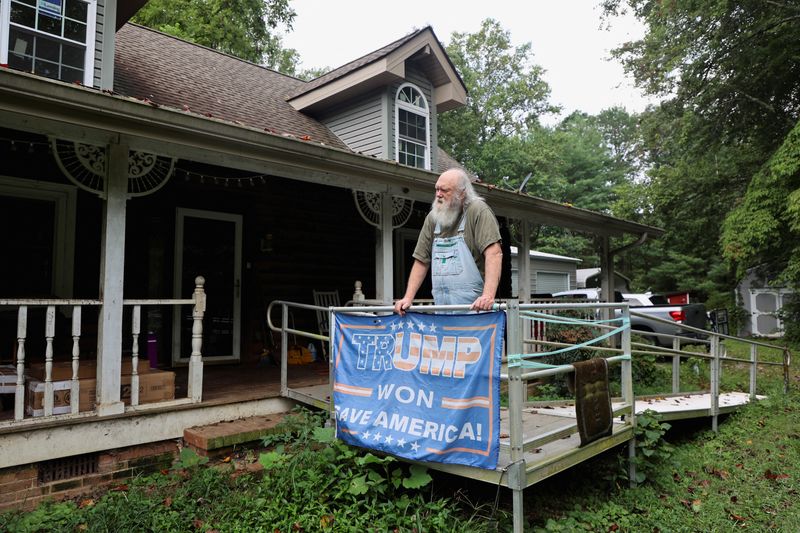
By Valerie Volcovici
HARRIMAN, Tennessee (Reuters) -Steve Hicks worked for 34 years at the Y-12 National Security Complex - which enriched the uranium for the atomic bomb that was dropped on Hiroshima in 1945 and to this day remains a key site in the United States nuclear weapons complex.
He is spending his retirement managing the 30 daily medications he takes to treat the effects of two cancers and nerve damage linked to radiation exposure and petitioning the U.S. Department of Health and Human Services to pay the medical bills for thousands of fellow Y-12 employees stricken with cancers associated with their employment.
"I made a good living there but I am not happy that I am this sick. And there are people who worked there that are sicker than me," Hicks, 70, said in an interview with Reuters.
Assembling the petitions is a complicated process. It can take years to gather the thousands of pages of evidence required to document the causes of 22 types of cancer the U.S. government recognizes as associated with radiation exposure at its nuclear workplaces.
Now Hicks' effort to win benefits and compensation for him and thousands of nuclear workers is in limbo after the HHS suspended indefinitely the expert medical bodies charged with reviewing those claims, according to interviews with 18 former workers, board members and administration officials.
And some of Hicks' petitioners do not have time to wait.
While Hicks did get medical coverage earlier for kidney cancer, he is now seeking assistance for treating skin cancer.
Hicks - who voted for Donald Trump - said he has sent dozens of letters to the president, Tennessee's senators and lawmakers in other states with major weapons facilities. "I've contacted politicians and the White House and haven't heard anything back."
The suspension of the board and its impact on the claims processes has not been previously reported.
The CDC, an agency of HHS, confirmed the indefinite suspension, but did not provide further details about the future of the board.
"Meetings of the Advisory Board on Radiation and Worker Health are currently paused due to outstanding administrative requirements, which the program is actively working to resolve," a CDC spokesperson told Reuters in a statement.
The White House declined to comment on the status of the board.
The Energy Department said in a statement that it is learning from past mistakes as it focuses on modernizing the nuclear arsenal. "The Department of Energy and NNSA (National Nuclear Security Administration) are continuing to learn from past experiences and are using that learning to improve our systems and practices to provide the safest possible work environment," the statement said.
THOUSANDS LEFT IN LIMBO
Over 700,000 people have been employed in the U.S. nuclear weapons complex since the heyday of the Cold War - mining, transporting and processing radioactive materials for military and civilian nuclear programs at 380 sites across the country.
The Energy Employees Occupational Illness Compensation Program Act, passed in 2000, entitles eligible workers at U.S. Department of Energy and Defense nuclear sites to a $150,000 lump-sum payment and medical insurance. The compensation is available to workers diagnosed with cancers associated with high exposure to radiation, or those who can demonstrate such exposure during their employment.
Since that time, U.S. presidents have appointed medical specialists, scientists and former workers to a review board to provide unbiased analysis of the compensation petitions.
As of last year, the U.S. had disbursed over $25 billion in compensation and medical benefits to 141,000 atomic weapons workers through the claims process, according to the Department of Energy.
The Advisory Board on Radiation and Workers' Health was in the process of reviewing eight more petitions from former workers at nuclear weapons manufacturing and uranium enrichment sites when the HHS on January 27 suspended its activities indefinitely as part of President Donald Trump's efforts to streamline the federal government.
And unless Trump reverses course and renews the presidential executive order constituting the review board, it could be wound down permanently as early as September, according to board members interviewed by Reuters.
Worker advocates told Reuters they had been planning to file three additional petitions this year - including the one assembled by Hicks. Each of these petitions represent claims from thousands of former nuclear workers.
Three of the board's 10 members told Reuters they have not met since last December and have received no information about whether or when it would reconvene.
"The board's suspension effectively stops the entire compensation process for nuclear workers, leaving many without the medical coverage and recognition they desperately need," said Brad Clawson, who worked as a spent nuclear fuel operator at the Idaho National Lab.
"Thousands and thousands of people still haven't had their day to prove that they were injured by this."
He said he received a phone call from a CDC employee in July telling him his membership has not been renewed but was given no further detail.
Another board member, Arthur Frank, an environmental and occupational health professor at Drexel University, told Reuters he has had no contact with the CDC about his board work and continues to send in time sheets every two weeks.
RISKY BUSINESS
Denise Degarmo, a retired political science professor, became involved in trying to get compensation for nuclear workers and their survivors after watching her father's painful death from an aggressive radiological cancer.
She said he had been a design engineer for the Intercontinental Ballistic Missile System and the Nike Missile system.
"In the last six weeks of his life, we couldn't even touch him, his bones would shatter," she told Reuters from her home north of Orlando, Florida. Her home office is filled with Cold War-era atomic memorabilia and thousands of documents she has dug up to support her petitions.
She says she has three petitions stalled in the queue, representing as many as 2,000 former workers and heirs, from plants including the Pinellas facility near St. Petersburg, that produced atomic bombs from 1957 to 1990.
"They all took loyalty oaths. They really promised the companies they would not tell anybody about what they were doing or what they are working with, not even their families," she said. "Although they've never been recognized as contributing in a positive way to the war, they're kind of our unsung heroes."
Like Degarmo, Hicks was inspired by his father, James Lee Hicks, who worked as a Y-12 machinist until he retired in 1994. A year later, his father was diagnosed with myeloid Leukemia - the result of his exposure to enriched uranium, his doctor said. He died of the disease at age 74 in 2008, according to death records reviewed by Reuters.
Before tighter safety protocols were introduced in 2000, Hicks said he would routinely hold enriched uranium against his chest and bare arms when loading it into machines, and clean up parts of the facility without submitting samples to the lab for safety tests, according to correspondence with lab officials reviewed by Reuters.
Hicks pointed to the scar on his arm from the carcinoma his doctor said was undoubtedly the result of exposure to enriched uranium.
"I knew there was a possible health effect," he said, but he wanted to help keep the US safe and Y-12 paid well. "I thought I was going to be the one to get out safe but I wasn't."
(Reporting by Valerie Volcovici in Harriman, Tennessee; Editing by Richard Valdmanis and Suzanne Goldenberg)

 Reuters US Domestic
Reuters US Domestic
 America News
America News Associated Press US and World News Video
Associated Press US and World News Video Raw Story
Raw Story Associated Press Elections
Associated Press Elections AlterNet
AlterNet MPR News Politics
MPR News Politics